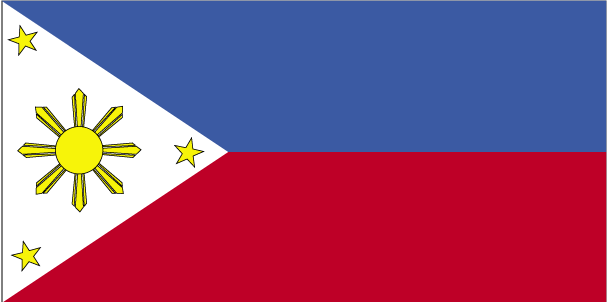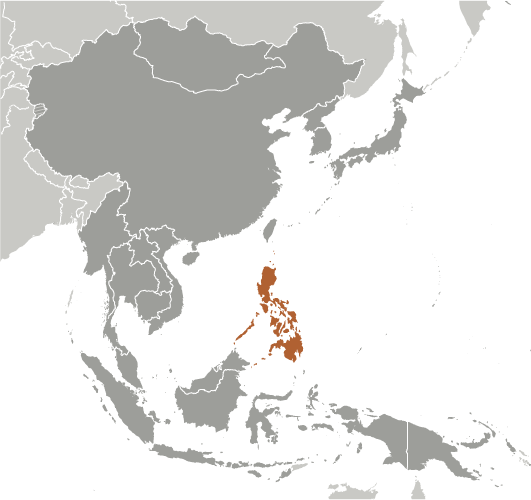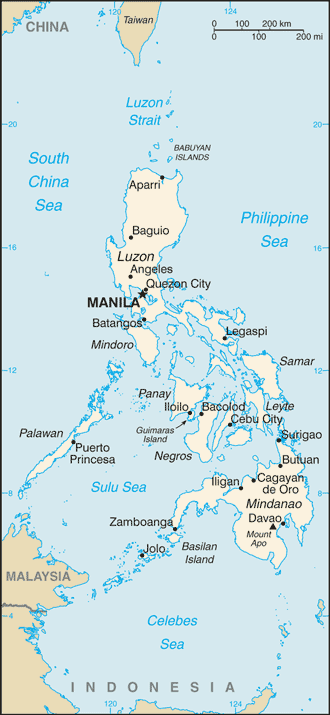
|
|
Advertisements:
GovernmentCountry name
Conventional long form Republic of the Philippines
Conventional short form Philippines Local long form Republika ng Pilipinas Local short form Pilipinas Government type
Republic
Capital
Name Manila
Geographic coordinates 14 36 N, 120 58 E Time difference UTC+8 (13 hours ahead of Washington, DC during Standard Time) Administrative divisions
80 provinces and 39 chartered cities Provinces Abra, Agusan del Norte, Agusan del Sur, Aklan, Albay, Antique, Apayao, Aurora, Basilan, Bataan, Batanes, Batangas, Biliran, Benguet, Bohol, Bukidnon, Bulacan, Cagayan, Camarines Norte, Camarines Sur, Camiguin, Capiz, Catanduanes, Cavite, Cebu, Compostela, Davao del Norte, Davao del Sur, Davao Oriental, Dinagat Islands, Eastern Samar, Guimaras, Ifugao, Ilocos Norte, Ilocos Sur, Iloilo, Isabela, Kalinga, Laguna, Lanao del Norte, Lanao del Sur, La Union, Leyte, Maguindanao, Marinduque, Masbate, Mindoro Occidental, Mindoro Oriental, Misamis Occidental, Misamis Oriental, Mountain Province, Negros Occidental, Negros Oriental, North Cotabato, Northern Samar, Nueva Ecija, Nueva Vizcaya, Palawan, Pampanga, Pangasinan, Quezon, Quirino, Rizal, Romblon, Samar, Sarangani, Siquijor, Sorsogon, South Cotabato, Southern Leyte, Sultan Kudarat, Sulu, Surigao del Norte, Surigao del Sur, Tarlac, Tawi-Tawi, Zambales, Zamboanga del Norte, Zamboanga del Sur, Zamboanga Sibugay Chartered cities Angeles, Antipolo, Bacolod, Baguio, Butuan, Cagayan de Oro, Caloocan, Cebu, Cotabato, Dagupan, Davao, General Santos, Iligan, Iloilo, Lapu-Lapu, Las Pinas, Lucena, Makati, Malabon, Mandaluyong, Mandaue, Manila, Marikina, Muntinlupa, Naga, Navotas, Olongapo, Ormoc, Paranaque, Pasay, Pasig, Puerto Princesa, Quezon, San Juan, Santiago, Tacloban, Taguig, Valenzuela, Zamboanga (2012) Independence
12 June 1898 (independence proclaimed from Spain); 4 July 1946 (from the US) National holiday
Independence Day, 12 June (1898); note - 12 June 1898 was date of declaration of independence from Spain; 4 July 1946 was date of independence from US Constitution
2 February 1987, effective 11 February 1987 Legal system
Mixed legal system of civil, common, Islamic, and customary law International law organization participation
Accepts compulsory ICJ jurisdiction with reservations; accepts ICCt jurisdiction Suffrage
18 years of age; universal
Executive branch
Chief of state
President Benigno AQUINO (since 30 June 2010); Vice President Jejomar BINAY (since 30 June 2010); note - president is both chief of state and head of government Head of government President Benigno AQUINO (since 30 June 2010) Cabinet Cabinet appointed by the president with consent of Commission of Appointments Elections President and vice president elected on separate tickets by popular vote for a single six-year term; election held on 10 May 2010 (next election to be held in May 2016) Election results Benigno AQUINO elected president; percent of vote - Benigno AQUINO 42.1%, Joseph ESTRADA 26.3%, seven others 31.6%; Jejomar BINAY elected vice president; percent of vote Jejomar BINAY 41.6%, Manuel ROXAS 39.6%, six others 18.8% Legislative branch
Bicameral Congress or Kongreso consists of the Senate or Senado (24 seats - one-half elected every three years; members elected at large by popular vote to serve six-year terms) and the House of Representatives or Kapulungan Ng Nga Kinatawan (287 seats - 230 members in one tier representing districts and 57 sectoral party-list members in a second tier representing special minorities elected on the basis of one seat for every 2% of the total vote but with each party limited to three seats); a party represented in one tier may not hold seats in the other tier; all House members are elected by popular vote to serve three-year terms Note The constitution limits the House of Representatives to 250 members; the number of members allowed was increased, however, through legislation when in April 2009 the Philippine Supreme Court ruled that additional party members could sit in the House of Representatives if they received the required number of votes Elections Senate - elections last held on 10 May 2010 (next to be held in May 2013); House of Representatives - elections last held on 10 May 2010 (next to be held in May 2013) Election results Senate - percent of vote by party - NA; seats by party - Lakas-Kampi CMD 4, LP 4, NP 4, NPC 2, PMP 2, LDP 1, PRP 1, independents 5; note - there are 23 rather than 24 sitting senators because one senator was elected mayor of Manila; House of Representatives - percent of vote by party - NA; seats by party - LP 119, Lakas-Kampi CMD 46, NPC 30, NP 22, others 10, independents 1, party-list 55; vacant seats - 1 district and 2 party-list Judicial branch
Supreme Court (15 justices are appointed by the president on the recommendation of the Judicial and Bar Council and serve until 70 years of age); Court of Appeals; Sandigan-bayan (special court for hearing corruption cases of government officials) Political parties and leaders
Laban ng Demokratikong Pilipino (Struggle of Filipino Democrats) or LDP [Edgardo ANGARA]; Lakas ng EDSA-Christian Muslim Democrats or Lakas-CMD [Gloria MACAPAGAL-ARROYO]; Liberal Party or LP [Manuel ROXAS]; Nacionalista Party or NP [Manuel VILLAR]; Nationalist People's Coalition or NPC [Frisco SAN JUAN]; PDP-Laban [Aquilino PIMENTEL]; People's Reform Party [Miriam Defensor SANTIAGO]; Puwersa ng Masang Pilipino (Force of the Philippine Masses) or PMP [Joseph ESTRADA] Political pressure groups and leaders
ABONO [Robert ESTRELLA]; AKBAYAN [Walden BELLO]; An Waray [Florencio NOEL]; Anak Mindanao [Mujiv HATAMIN]; ANAKPAWIS [Rafael MARIANO]; ARC [Narciso SANTIAGO III]; Association of Philippine Electric Cooperatives (APEC) [Ponciano PAYUYO]; A TEACHER [Mariano PIAMONTE]; BAGON HENERASYON [Bernadette HERRERA-DY]; Bayan Muna [Teodoro CASINO, Jr.]; Black and White Movement [Vicente ROMANO]; BUHAY [Rene VELARDE]; BUTIL [Leonila CHAVEZ]; CIBAC [Cinchoa CRUZ-GONZALES]; COOP-NATCO [Jose PING-AY]; GABRIELA [Luzviminda ILAGAN]; KABATAAN [Raymon PALATINO]; Kilosbayan [Jovito SALONGA]; YACAP [Carol LOPEZ]
International organization participation
ADB, APEC, APT, ARF, ASEAN, BIS, CD, CICA (observer), CP, EAS, FAO, G-24, G-77, IAEA, IBRD, ICAO, ICC, ICRM, IDA, IFAD, IFC, IFRCS, IHO, ILO, IMF, IMO, IMSO, Interpol, IOC, IOM, IPU, ISO, ITSO, ITU, ITUC, MIGA, MINUSTAH, NAM, OAS (observer), OPCW, PCA, PIF (partner), UN, UNCTAD, UNDOF, UNESCO, UNHCR, UNIDO, Union Latina, UNMIL, UNMISS, UNMIT, UNMOGIP, UNOCI, UNWTO, UPU, WCO, WFTU, WHO, WIPO, WMO, WTO Diplomatic representation in the us
Chief of mission Ambassador Jose L. CUISIA Jr.
Chancery 1600 Massachusetts Avenue NW, Washington, DC 20036 Telephone [1] (202) 467-9300FAX [1] (202) 467-9417 Consulate(s) general Chicago, Honolulu, Los Angeles, New York, Saipan (Northern Mariana Islands), San Francisco, Tamuning (Guam) Diplomatic representation from the us
Chief of mission Ambassador Harry K. THOMAS Jr.
Embassy 1201 Roxas Boulevard, Ermita 1000, Manila Mailing address PSC 500, FPO AP 96515-1000Telephone [63] (2) 301-2000 FAX [63] (2) 301-2399 Flag description
Two equal horizontal bands of blue (top) and red; a white equilateral triangle is based on the hoist side; the center of the triangle displays a yellow sun with eight primary rays; each corner of the triangle contains a small, yellow, five-pointed star; blue stands for peace and justice, red symbolizes courage, the white equal-sided triangle represents equality; the rays recall the first eight provinces that sought independence from Spain, while the stars represent the three major geographical divisions of the country: Luzon, Visayas, and Mindanao; the design of the flag dates to 1897 Note In wartime the flag is flown upside down with the red band at the top National symbol(s)
Philippine eagle
National anthem
Name
"Lupang Hinirang" (Chosen Land) Lyrics/music Jose PALMA (revised by Felipe PADILLA de Leon)/Julian FELIPE Note Music adopted 1898, original Spanish lyrics adopted 1899, Filipino (Tagalog) lyrics adopted 1956; although the original lyrics were written in Spanish, later English and Filipino versions were created; today, only the Filipino version is used
Comments
Add a new comment: |
Advertisement
Members area
Philippines (Manila):
 
GPS points from Philippines (Manila)
|
||||||||

 The Philippine Islands became a Spanish colony during the 16th century; they were ceded to the US in 1898 following the Spanish-American War. In 1935 the Philippines became a self-governing commonwealth. Manuel QUEZON was elected president and was tasked with preparing the country for independence after a 10-year transition. In 1942 the islands fell under Japanese occupation during World War II, and US forces and Filipinos fought together during 1944-45 to regain control. On 4 July 1946 the Republic of the Philippines attained its independence. A 20-year rule by Ferdinand MARCOS ended in 1986, when a "people power" movement in Manila ("EDSA 1") forced him into exile and installed Corazon AQUINO as president. Her presidency was hampered by several coup attempts that prevented a return to full political stability and economic development. Fidel RAMOS was elected president in 1992. His administration was marked by increased stability and by progress on economic reforms. In 1992, the US closed its last military bases on the islands. Joseph ESTRADA was elected president in 1998. He was succeeded by his vice-president, Gloria MACAPAGAL-ARROYO, in January 2001 after ESTRADA's stormy impeachment trial on corruption charges broke down and another "people power" movement ("EDSA 2") demanded his resignation. MACAPAGAL-ARROYO was elected to a six-year term as president in May 2004. Her presidency was marred by several corruption allegations but the Philippine economy was one of the few to avoid contraction following the 2008 global financial crisis, expanding each year of her administration. Benigno AQUINO III was elected to a six-year term as president in May 2010. The Philippine Government faces threats from several groups, some of which are on the US Government's Foreign Terrorist Organization list. Manila has waged a decades-long struggle against ethnic Moro insurgencies in the southern Philippines, which has led to a peace accord with the Moro National Liberation Front and on-again/off-again peace talks with the Moro Islamic Liberation Front. The decades-long Maoist-inspired New People's Army insurgency also operates through much of the country. The Philippines faces increased tension with China over disputed territorial claims in the South China Sea.
The Philippine Islands became a Spanish colony during the 16th century; they were ceded to the US in 1898 following the Spanish-American War. In 1935 the Philippines became a self-governing commonwealth. Manuel QUEZON was elected president and was tasked with preparing the country for independence after a 10-year transition. In 1942 the islands fell under Japanese occupation during World War II, and US forces and Filipinos fought together during 1944-45 to regain control. On 4 July 1946 the Republic of the Philippines attained its independence. A 20-year rule by Ferdinand MARCOS ended in 1986, when a "people power" movement in Manila ("EDSA 1") forced him into exile and installed Corazon AQUINO as president. Her presidency was hampered by several coup attempts that prevented a return to full political stability and economic development. Fidel RAMOS was elected president in 1992. His administration was marked by increased stability and by progress on economic reforms. In 1992, the US closed its last military bases on the islands. Joseph ESTRADA was elected president in 1998. He was succeeded by his vice-president, Gloria MACAPAGAL-ARROYO, in January 2001 after ESTRADA's stormy impeachment trial on corruption charges broke down and another "people power" movement ("EDSA 2") demanded his resignation. MACAPAGAL-ARROYO was elected to a six-year term as president in May 2004. Her presidency was marred by several corruption allegations but the Philippine economy was one of the few to avoid contraction following the 2008 global financial crisis, expanding each year of her administration. Benigno AQUINO III was elected to a six-year term as president in May 2010. The Philippine Government faces threats from several groups, some of which are on the US Government's Foreign Terrorist Organization list. Manila has waged a decades-long struggle against ethnic Moro insurgencies in the southern Philippines, which has led to a peace accord with the Moro National Liberation Front and on-again/off-again peace talks with the Moro Islamic Liberation Front. The decades-long Maoist-inspired New People's Army insurgency also operates through much of the country. The Philippines faces increased tension with China over disputed territorial claims in the South China Sea.